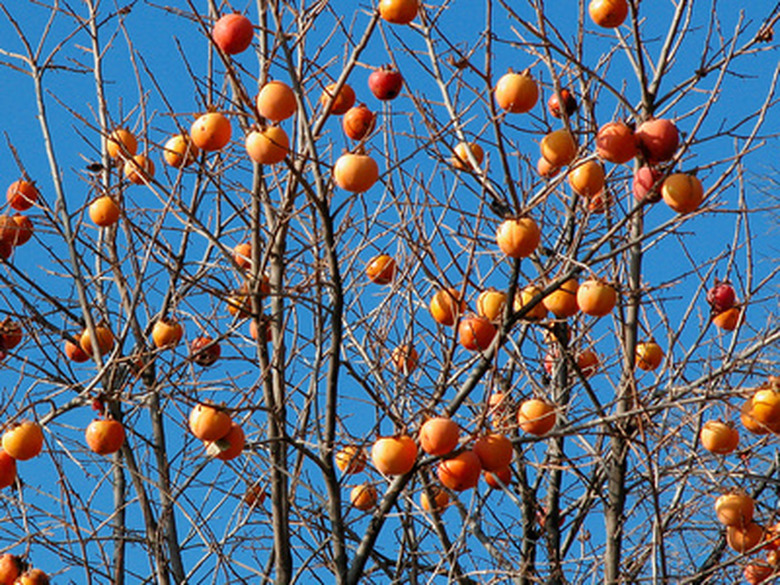Diseases Of The Persimmon Tree
Persimmon trees are excellent, interesting specimen trees, according to Edward F. Gilman, a horticulturist with the University of Florida. The common persimmon (Diospyros virginiana) is native to America and grows well in U.S. Department of Agriculture (USDA) hardiness zones 4 through 8a. The non-native Japanese persimmon (Diospyros kaki) is not as cold-hardy as the common persimmon but has superior fruit, according to David Parker, a horticulturist with Clemson University. Both trees can suffer from a number of diseases.
Leaf Spot
Leaf spot is a fungal disease caused by a several different types of fungi. The disease causes ugly spots to appear on the leaves of the tree. In some cases, the spots fall out, leaving the leaves with a "holey" appearance. In other cases, depending on the particular fungus, the spots may enlarge and spread, become greasy in texture, or develop raised edges. Often, the leaves will curl or shrivel up. Affected leaves may even drop prematurely from the tree. If the fruit is infected, the skin may develop spots or split open.
- Persimmon trees are excellent, interesting specimen trees, according to Edward F. Gilman, a horticulturist with the University of Florida.
- In other cases, depending on the particular fungus, the spots may enlarge and spread, become greasy in texture, or develop raised edges.
While leaf spot is unattractive, it is not fatal to the tree. Once a tree is infected, the disease must run its course. To prevent the disease from returning the next year, rake up dropped leaves so the fungus does not overwinter in the soil. Many of the fungi spread on water, so avoid wetting the leaves of the tree during irrigation. Chemical methods such as applying a fungicide are often ineffective, as thorough coverage of trees of this size (up to 60 feet tall) can be difficult.
Vascular Wilt
Vascular wilt is a disease of the water-carrying system of the persimmon tree, including the roots. In persimmon trees, it is caused by fungi of the genre Verticillium. These diseases are not limited to persimmon trees, but can infect vegetables and other plants as well.
- While leaf spot is unattractive, it is not fatal to the tree.
- Many of the fungi spread on water, so avoid wetting the leaves of the tree during irrigation.
As the disease progresses through the tree, the persimmon leaves wilt and begin to turn light green and yellow. Over time, they turn brown and shrivel up. The wood also becomes discolored. Fruit may not develop at all, or it may develop in a disfigured form, or develop partially and then wither and die. Eventually, the tree will die.
The fungi that cause Verticillium wilt live in the soil, and cannot be killed by spraying the tree with a fungicide. Drenching the soil with a fungicide is also usually ineffective, according to J. Louter, a horticulturist with the University of Guelph. The best way to deal with the disease is to prevent it by planting wilt-resistant varieties of persimmon trees in soil that is free of the pathogen.
- As the disease progresses through the tree, the persimmon leaves wilt and begin to turn light green and yellow.
- The fungi that cause Verticillium wilt live in the soil, and cannot be killed by spraying the tree with a fungicide.
Twig Blight
Twig blight occurs when the twigs of a persimmon tree begin to die back from the tips inward. This is usually caused by a fungal disease that infects the sapwood of the tree. The fungus enters the tree on the bodies of insects, most commonly, the persimmon borer. As the insect bores into the wood of the tree, the fungus infects the wood.
Twig blight can affect individual branches, causing cankers to develop (dark, sunken, cracked areas of dead wood), or it can affect the entire tree. In the case of the former, the branches can be pruned off in order to stop the spread of the disease. If the tree begins to die from the crown downward, the heartwood is probably infected and the tree will die.
- Twig blight occurs when the twigs of a persimmon tree begin to die back from the tips inward.
- Twig blight can affect individual branches, causing cankers to develop (dark, sunken, cracked areas of dead wood), or it can affect the entire tree.
Once a tree is infected, it can only be saved if the diseased limbs are pruned off. The best way to prevent the disease is to control for insects that may carry the fungus. Watch your tree for signs of an insect infestation, and spray the tree with insecticide if necessary.
